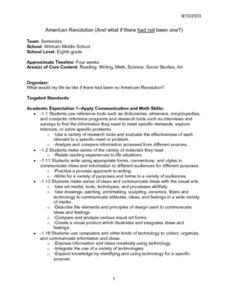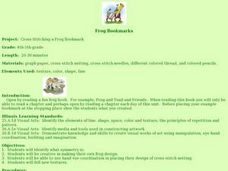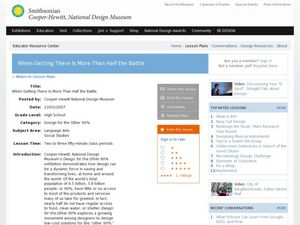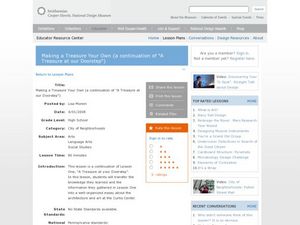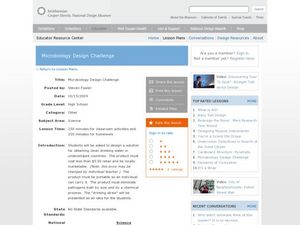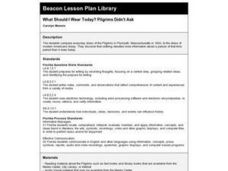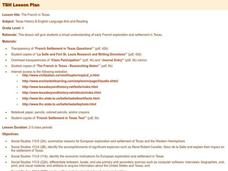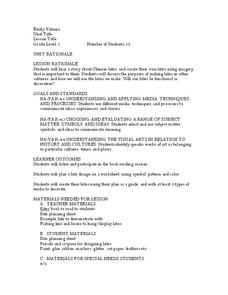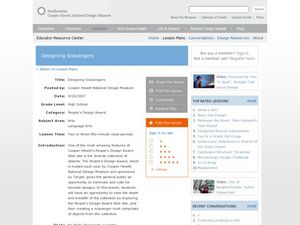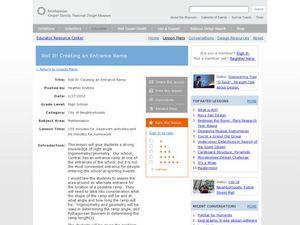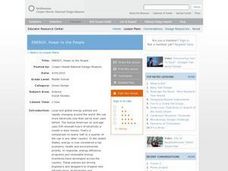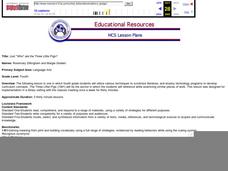Curated OER
American Revolution (And What if There Had Not Been One?)
Eighth graders create scenes that might have existed if the American Revolution had not taken place. They use information they have gathered to plan, produce, and present a variety of products from the perspective of a British citizen in...
Curated OER
Cross-Stitching a Frog Bookmark
Students identify symmetry and create their own frog design. Students apply hand-eye coordination in placing their designs of cross-stitch netting. Students identify with new textures. Students present and analyze their design once...
Curated OER
Designing A Mythical Creature
Students study mythology and why human cultures require them. In this investigating myths instructional activity students design a creature that fits an explanation of a natural phenomena then demonstrate the concept of "myth" and...
Curated OER
A Treasure at our Doorstep
Young scholars write a descriptive essay about a historical landmark in their area, such as the Curtis Center in Philadelphia, PA. In this historical landmarks lesson, students use their senses to detail information about the chosen...
Curated OER
Science TV: Making it Real
Students explore the ways science is presented in a children's television show. Students conduct internet research, and then create and design a skit that highlights the problem-solving process.
Curated OER
When Getting There is More Than Half the Battle
High schoolers investigate the 'Design for the Other 90%' exhibition about low-cost solutions to give the "other 90% of the world's population" access to services and amenities many of us take for granted. In this technology design...
Curated OER
Making a Treasure Your Own: Lesson Two
Pupils write an essay describing the Curtis Center and what they learned there. In this descriptive writing essay, students discuss the five paragraph essay and review sensory discoveries from their trip. Pupils draft an outline and work...
Curated OER
Changing the World: Social Entrepreneurs Part Two
Pupils explore the work of social entrepreneurs. For this entrepreneurship lesson, students research a specific entrepreneur and create a presentation introducing him or her to the class. Pupils design a seminar on social...
Curated OER
Microbiology Design Challenge
Students discover dangers to human health by researching what's in our drinking water. In this water purification instructional activity, students discuss the conditions of water in undeveloped countries and why it is unsafe to...
Curated OER
Wild Things - Texture And Pattern
Pupils implement textures and patterns in creating an imaginary Wild Thing, using the book and illustrations in Where the Wild Things Are by Maurice Sendak serve as Inspiration.
Curated OER
Then, Now, and Tomorrow
Students will use this unit to investigate the past, present, and future of the architecture and plan of New York's Lower East Side. Students will research the history of the Lower East Side neighborhood in photographs used from the...
Curated OER
Connecting the Dots? Geometry and Architecture
Students examine the connection between geometry and architecture. In this geometry and architecture lesson, students view a video which details a geometry class design project. Students then use the Internet in a scavenger hunt to find...
Curated OER
What Should I Wear Today? Pilgrims Didn't Ask
Second graders compare the clothing of today with the everyday dress of the Pilgrims.
Curated OER
The French in Texas
Fourth graders gain a broad understanding of early French exploration and settlement in Texas. They access websites imbedded in this plan. Using their notes, 4th graders work alone or with a partner to create an illustrated journal with...
Curated OER
Haiku - Poetry of the Samurai Warrior
Students research the Samurai and their Haiku Writings. Students use internet research to gather information about the ancient Japanese Samurai. The students then create individual Haiku writings, and a cultural day is designated when...
Curated OER
Chinese Kites
First graders investigate the concept of kite making in the culture of China. They design and create their own kites. The purposes of making kites is discussed and the question of a kite's functionality is covered.
Curated OER
Designing Scavengers
Students write a headline that captures the most important aspects of the People's Design Award. In this design instructional activity, students are introduced to The People's Design Award and collaborate to create a headline for a...
Curated OER
Roll It! Creating an Entrance Ramp
Students explore the concept of triangles. In this triangles instructional activity, students are to propose a plan for a ramp at their school. Students use the Pythagorean Theorem and trigonometry to determine the length,...
Curated OER
Middleton/Kuna History Teleconference
Third graders study the history and building of Middleton and Kuna. They create timelines of significant events in the towns' histories. Finally, they create a website dealing with Middleton and Kuna history.
Curated OER
Using "Why Mosquitoes Buzz in People's Ears" to Teach Cause and Effect
Students discuss cause and effect relationships and the chain reaction involved before listening to the story "Why Mosquitoes Buzz in People's Ears". Students create flow charts to show the chain reactions of causes and effects in the...
Curated OER
Novel Study Unit of The Outsiders by S.E. Hinton
Ninth graders will speak and listen to explore, clarify, extend, and reflect on their thoughts, ideas, feelings, and experiences. They will be able to communicate information and ideas effectively and clearly, and to respond personally...
Curated OER
Create Koi Nobori: Carp Kites
Students study the Japanese art of Koi Nabori or carp kites. They create their own carp kites with repeating patterns.
Curated OER
Energy: Power to the People
High schoolers explore the concept of renewable energy. In this green design lesson, students research local energy issues facing their community and create policies to address the issues.
Curated OER
Just "Who" are the Three Little Pigs?
Fourth graders use a Venn diagram to compare and contrast various versions of the story The Three Little Pigs. They write a Cinquain, and then act out their version of the Three Little Pigs in a skit.
